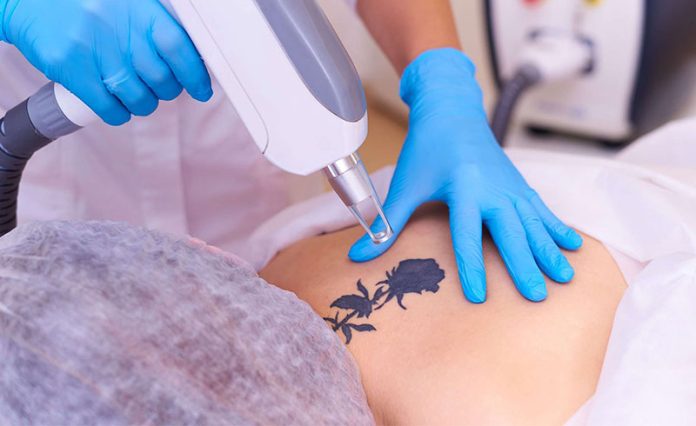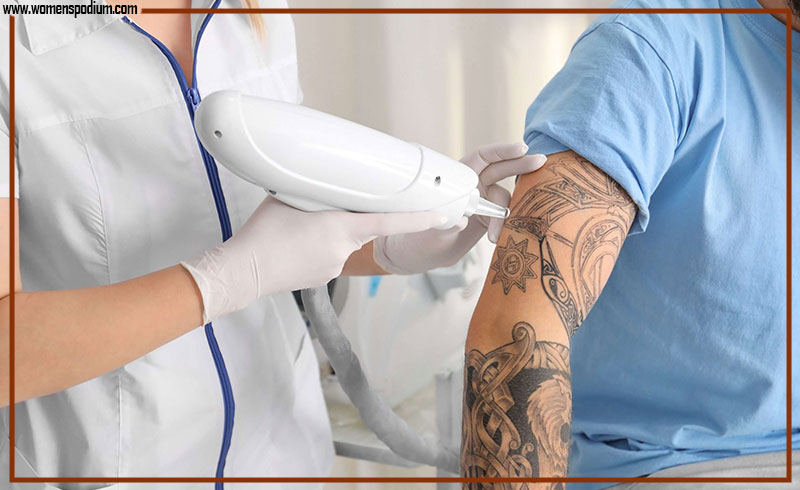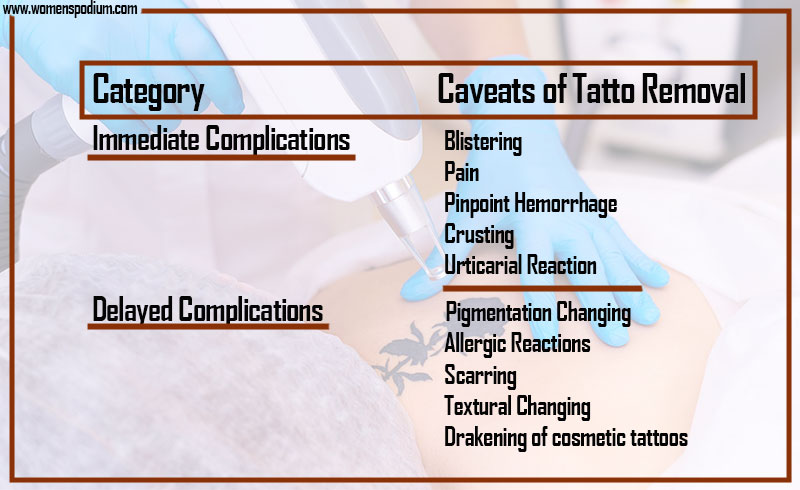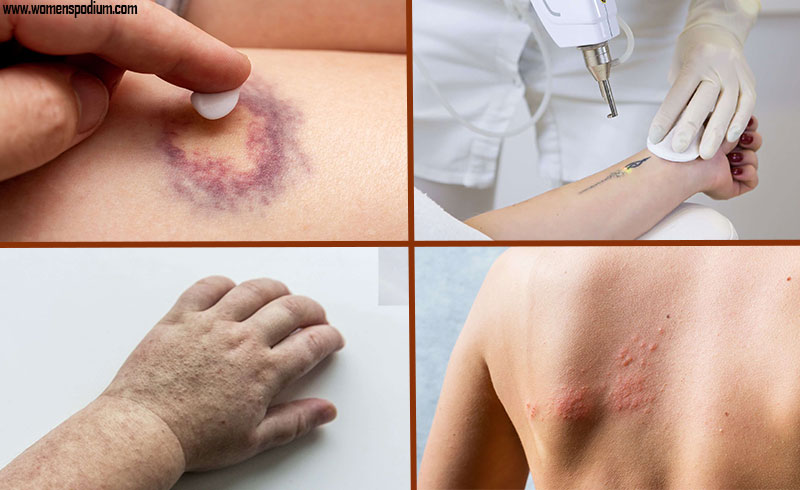
It’s crucial for everyone with a tattoo to consider the caveats or limitations before opting for the laser tattoo removal procedure. This will help them make a well-informed decision about their current situation. In this blog, you’ll get insight into the ten primary caveats of laser tattoo removal. But before jumping into the limitations, you must know what laser tattoo removal is and how laser tattoo removal works!
Laser Tattoo Removal: What Is It?

Laser tattoo removal is an advanced skin treatment procedure that uses high-powered lasers for deep penetration into the skin. It removes the ink particles within the cells responsible for the coloration of the tattoo. The answer to the question, how laser tattoo removal works depends on the tattoo’s ink color, various types of lasers can be utilized to remove tattoos.
The treatment procedure for laser tattoo removal depends on the person’s traits and the tattoo. Most individuals will need to undergo a series of short tattoo removal sessions at an interval of 1-2 months for removing the tattoo. However, it’s unpredictable to tell the exact number of sessions required. Typically, a person only needs 5-10 sessions, but they may need up to 20 sessions in some rare cases. The variability is determined by the factors such as the color, age, location, and size of the tattoo.
With recent advancements in technology, the result of laser tattoo removal has emerged to be more positive and successful by decreasing the risk of adverse effects and increasing efficacy.
Caveats of Tattoo Removal

It can sometimes be challenging to obliterate a tattoo, especially for those who consider colored tattoo removal or people having dark-colored skin. After the laser treatment, many individuals can experience changes in the color of their skin or the skin texture.
A series of laser treatments are necessary for the complete tattoo removal of the majority of individuals who undergo this treatment procedure. This laser treatment significantly increases the risk of laser light exposure, thus triggering the risk of related complications. Also, the treatment series can be costly.
This treatment procedure can be uncomfortable and may result in causing pain in the individual’s treatment area. To minimize this effect, injection of local anesthesia is a must before the treatment. Moreover, laser light has the capability to affect eyesight by harming the eyes. For this reason, individuals should wear protective eye goggles.
At times, the laser tattoo removal procedure can sometimes result in skin infection, especially when a spot of the treatment is ignored. Individuals must protect the treated skin area, which will lower the risk of bacterial attack and subsequent infection. This is why adequate aftercare is essential after the treatment.
Immediate Complications: Caveats of Tattoo Removal

1. Blistering
Individuals will experience blisters, which are most common in dark skin. Applying the laser light via a microscope glass slide can reduce the blisters.
2. Pain
It’s most common to experience pain immediately after tattoo removal. However, local anesthesia reduces the pain drastically. Individuals can also apply a topical anesthetic cream to ease the pain during the laser procedure.
3. Crusting
If the individual experiences crusting, they should be prescribed a topical antibiotic or topical emollient. Also, the individual shouldn’t pick at the crusts as it can result in pigmentary changes.
4. Pinpoint Hemorrhage
Pinpoint hemorrhage occurs spontaneously after the treatment. It can occur when a blood vessel breaks due to some reaction and blood starts to leak in the skin.
5. Urticarial Reaction
In some cases, the urticarial lesion has been reported as one of the major caveats of laser tattoo removal. It results in the formation of itchy, red welts around the affected skin area.
Delayed Complications: Caveats of Tattoo Removal

1. Pigmentary Changes
Pigmentary changes, including hyperpigmentation or hypopigmentation, are the two most common caveats of tattoo removal. The majority of these pigmentary changes are transient. These changes occur primarily after 4-6 weeks of laser treatment.
However, individuals can experience long-lasting pigmentary changes, especially those with tanned or darker skin. One of the stat shows that 22% of patients with dark skin experience hyperpigmentation, whereas only 8% of them experience hyperpigmentation.
2. Allergic Reactions
Individuals can experience local allergic reactions after laser treatment, especially to the yellow and red pigment, in the form of scaly plaques, nodules, and pruritic papules. In rare cases, people get systemic reactions after the laser treatment of allergic tattoos.
It’s the yellow or red ink where the photoallergic reactions can start to occur. These allergic reactions can either be early or delayed after a few months or years from the tattoo removal. One of the best ways to treat these allergic reactions is using intralesional and topical corticosteroids.
3. Darkening of Cosmetic Tattoos
Suppose the individual undergoes a tattoo removal procedure for tan/white-colored, or light-colored pink tattoos, which they often use for permanent makeup (micropigmentation). In that case, they can experience the paradoxical darkening of the tattoos. This happens when the laser reduces the iron oxide or titanium oxide, making the pigment turn black.
4. Textural Changes
After the laser tattoo removal procedure, the individual may experience textural changes, which can be either be permanent or transient. However, one can avoid the caveat with adequate medications.
5. Scarring
If individuals use a high fluence, especially with dark skin or tanned skin, they may experience scarring. This caveat occurs due to the high absorption rate of the laser radiation by their skin’s epidermal melanin.
Final Thoughts
This was all the necessary information about how laser tattoo removal works. Therefore, it’s mandatory to boost youth’s awareness regarding the increased risks and caveats related to tattooing when made in a potentially unprofessional environment. Moreover, tattoo parlors should be well-educated about the limitations involved and the significance of using infection-control tattoo-making procedures. No matter the limitations, it’s possible to avoid most of them with great success. It’s only a matter of time to benefit from the best laser tattoo removal center for the safest and optimal experience.
Also Read: Include essential oils in your daily routine. These are anti-fungal. They contain antioxidants, reduce inflammation, and have anti-aging benefits. These oils are often helpful in cleansing and treating acne, wrinkles, and many other skin-related issues.





